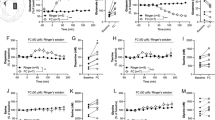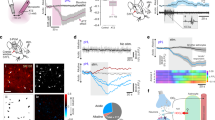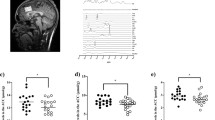Abstract
GLUTAMIC ACID (glu) may be the transmitter of a large proportion of excitatory synapses in the brain1, but glu is also important in cell metabolism, and the apparent lack of biochemical ‘markers’ associated with the role of glu as a synaptic transmitter has until recently hampered the localisation of potential ‘glutamergic’ neurones. High affinity uptake of glu2,3 is, however, highly specific2 and seems to be selectively localised in the excitatory granular cell terminals in the cerebellum4, and in three systems of excitatory nerve endings in the hippocampal formation, as shown by autoradiography5 and quantitative measurements6. In the conditions used in these studies, glial uptake of glu7,8 was found not to be quantitatively important. In the hippocampal systems, iontophoretic studies9 and release experiments10 strongly suggest that glu, and/or aspartic acid (asp), may be the transmitter. It thus seems that high affinity uptake of glu may be useful as a marker for putative glutamergic and/or aspartergic nerve endings. The question of whether the uptake of [3H]glu, as measured in vitro, represents net accumulation or homoexchange11 is not crucial in the present context. The neostriatum (nucleus caudatus–putamen) receives a large excitatory projection from the neocortex12,13. Iontophoretic studies suggest that this could use glu or asp as its transmitter1,14. We here demonstrate that high affinity uptake of glu is selectively reduced in the neostriatum after lesions in the neocortex.
This is a preview of subscription content, access via your institution
Access options
Subscribe to this journal
Receive 51 print issues and online access
$199.00 per year
only $3.90 per issue
Buy this article
- Purchase on Springer Link
- Instant access to full article PDF
Prices may be subject to local taxes which are calculated during checkout
Similar content being viewed by others
References
Curtis, D. R. & Johnston, G. A. R. Ergebn. Physiol. 69, 97–188 (1974).
Balcar, V. J. & Johnston, G. A. R. J. Neurochem. 19, 2657–2666 (1972).
Logan, W. J. & Snyder, S. H. Brain Res. 42, 413–431 (1972).
Young, A. B., Oster-Granite, M. L., Herndon, R. M. & Snyder, S. H. Brain Res. 73, 1–13 (1974).
Iversen, L. L. & Storm-Mathisen, J. Acta physiol. scand. 96, 22A–23A (1976).
Storm-Mathisen, J. Brain Res. 120, 379–386 (1977).
Hökfelt, T. & Ljungdahl, Å. in Studies of Neurotransmitters at the Synaptic Level (ed. Costa, E., Iversen, L. L., and Paoletti, R.) Adv. Biochem. Psychopharmac. 6, 1–36 (1972).
Henn, F. A., Goldstein, M. N. & Hamberger, A. Nature, 249, 663–664 (1974).
Schwartzkroin, P. A. & Andersen, P. in Properties of Dendrites (ed. Kreutzberg, G. W.) Adv. Neurol. 12, 45–51 (1975).
Nadler, J. V., Vaca, K. W., White, W. F., Lynch, G. S. & Cotman, C. W. Nature, 260, 538–540 (1976).
Levi, G., Bertollini, A., Chen, J. & Raiteri, M. J. Pharmac. exp. Ther. 188, 429–438 (1974).
Webster, K. E. J. Anat. 95, 532–544 (1961).
Buchwald, D. N., Price, D. D., Vernon, L. & Hull, C. D. Expl Neurol. 38, 311–321 (1973).
Spencer, H. J. Brain Res. 102, 91–101 (1976).
Iversen, L. L. & Johnston, G. A. R. J. Neurochem., 18, 1939–1950 (1971).
Lowry, O. H., Rosebrough, N. J., Farr, A. L. & Randall, R. J. J. biol. Chem. 193, 265–275 (1951).
Fonnum, F., Storm-Mathisen, J. & Walberg, F. Brain Res. 20, 259–275 (1970).
Fonnum, F. in Research Methods in Neurochemistry (eds. Marks, N. & Rodnight, R.) 3, 253–275 (Plenum, New York, 1975).
Broch, O. J. & Fonnum, F. J. Neurochem. 19, 2049–2055 (1972).
Carman, J. B., Cowan, W. M., Powell, T. P. S. & Webster, K. E. J. Neurol. Neurosurg. Psychiat. 28, 71–77 (1965).
Author information
Authors and Affiliations
Rights and permissions
About this article
Cite this article
DIVAC, I., FONNUM, F. & STORM-MATHISEN, J. High affinity uptake of glutamate in terminals of corticostriatal axons. Nature 266, 377–378 (1977). https://doi.org/10.1038/266377a0
Received:
Accepted:
Issue Date:
DOI: https://doi.org/10.1038/266377a0
This article is cited by
-
Rapid Regulation of Glutamate Transport: Where Do We Go from Here?
Neurochemical Research (2022)
-
After-training emotional interference may modulate sequence awareness in a serial reaction time task
Experimental Brain Research (2012)
-
Induction of NOS and nitrotyrosine expression in the rat striatum following experimental hepatic encephalopathy
Metabolic Brain Disease (2009)
-
An in vitro electrophysiological study on the effects of phenytoin, lamotrigine and gabapentin on striatal neurons
British Journal of Pharmacology (1999)
-
Effects of kainic acid, quisqualic acid, and their antagonist, pCB-PzDA, on rat electrocorticograms and monoamine metabolite levels in rat striatum
Neurochemical Research (1994)
Comments
By submitting a comment you agree to abide by our Terms and Community Guidelines. If you find something abusive or that does not comply with our terms or guidelines please flag it as inappropriate.



